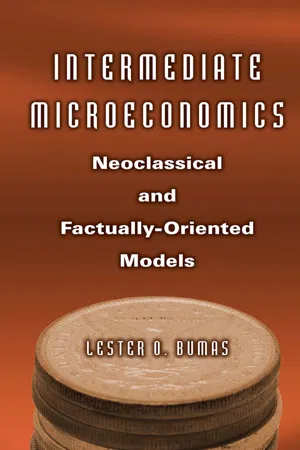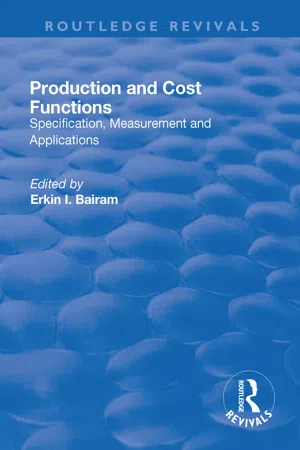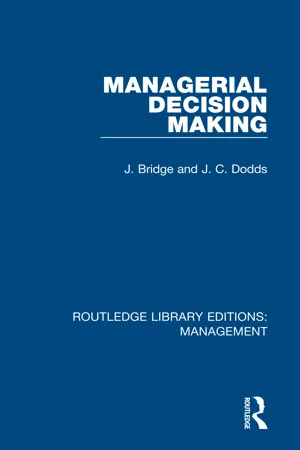Cost Function
A cost function is a mathematical formula that represents the relationship between the cost of production and the level of output. It helps businesses analyze and optimize their production processes by identifying the costs associated with producing goods or services. By understanding the cost function, businesses can make informed decisions about pricing, production levels, and resource allocation.
8 Key excerpts on "Cost Function"
- eBook - ePub
Intermediate Microeconomics
Neoclassical and Factually-oriented Models
- Lester O. Bumas(Author)
- 2015(Publication Date)
- Routledge(Publisher)
...CHAPTER SIX Cost Functions The number of traditional Cost Functions is seven: three kinds of total cost (total, total variable, and total fixed), three related kinds of average cost (average, average variable, and average fixed), plus marginal cost. It is important to know the meaning of each of these costs, how the average and marginal and totals are related, and the ways in which each of the costs is of importance. Cost Functions fall into the time horizon established by Alfred Marshall: the market, short-run, and long-run periods. Emphasis at the outset is on short-run functions, the Cost Functions related to actual productive activities. Then long-run Cost Functions are considered. They are useful in planning new facilities, particularly the structure, equipment, and method of production expected to yield minimum cost per unit of production. Finally, some of the major aspects of transaction costs are discussed. In common usage, Cost Functions unadorned with any designation are short-run in character—the functions associated with actual production. Cost Functions pose a problem since those found in empirical studies are basically different from the logic-based functions of the neoclassical paradigm. Moreover, empirical Cost Functions tend to be inconsistent with the neoclassical production function. Total Cost and Its Constituents Two sets of Cost Functions are presented. The first is based on the total Cost Functions generally found in textbooks and probably in agriculture. This function starts out with a decreasing slope which becomes increasing as the rate of production increases. Such a total cost curve yields “U”-shaped average, average variable, and marginal cost curves. The marginal Cost Function equals the average variable and average Cost Functions at their minimum...
- eBook - ePub
Production and Cost Functions
Specification, Measurement and Applications
- Erkin Bairam, Erkin Bairam(Authors)
- 2018(Publication Date)
- Routledge(Publisher)
...Many economists and econometricians tend to interpret the financial data provided by accountants from the viewpoint of neo-classical economic theory. Due to the difficulties associated with operationalising this theoretical approach significant problems arise in econometric work in comparing facts with theories. An alternative approach to understanding the nature and properties of production, cost and profit functions based upon accounting measurements is outlined in this chapter. Basic concepts are defined at the most micro-economic level in terms of observable (and measurable) variables. It is shown how this characterization supports a general statistical understanding of production, cost and profit functions and how it relates to the problem of aggregation. II. Production and Cost Functions in Economic Theory The term ‘production function’ in economic theory is usually associated with the description of hypothetical physical input-output relationships, i.e. the variables described by the particular theory are expressed in non-financial measurements. The general functional specification is O = f (I i), i = 1 t o n (1) where O is a physical output measure and the I i are physical input measures. 6 In theoretical analysis the inputs are often restricted to two different kinds, denoted L and K to stand for ‘labour’ and ‘capital’ respectively. An example of one such theory is the so-called ‘Cobb-Douglas’ production function, O = A (t) L α K β (2) Here A(t) is a time dependent ’scale parameter’ which supposedly denotes a technological progress variable and α and β are further parameters affecting the shape of the relationship between the dependent and independent variables. 7 Many other specific forms of production functions have been discussed theoretically and examined econometrically...
- eBook - ePub
Microeconomics
A Global Text
- Judy Whitehead(Author)
- 2014(Publication Date)
- Routledge(Publisher)
...6 Costs and Scale Traditional Cost Theory: Short-run, Long-run ; Modern Cost Theory: Short-run, Long-run ; Economies of Scale. Returns to Scale and the Homogeneous Production Function: The Cobb–Douglas Production Function. Cost Functions are derived from production functions and show the relationship between the quantity produced and the cost of production. This cost of production is the cost of the factor inputs used in the production process. As a result, there is a direct relationship between the production function and the Cost Function. In an era with an emphasis on cost competitiveness, it is essential to have an understanding of the nature of Cost Functions, differences between short- and long-run costs and the significance of scale for unit costs. Cost theory is examined with regard to the traditional theory and the modern theory. Each of these is divided into the short-run and the long-run. The short-run considers the relationships among total, average and marginal costs. This provides a backdrop for the study of the nature of long-run costs and the significance of scale for the producer. The special case of the Cobb–Douglas production function is examined in order to understand its special properties and the significance for scale and cost competitiveness. 6.1 Traditional Cost Theory – The Short-Run The laws of production are given to economists by engineers and others who design production plants. These are the ones who determine the real relationships between inputs and outputs. The laws describe the technically possible ways of increasing the level of production. In the short-run, the Cost Function (C) may be written simplistically as a function of the quantity of output (Q) as: where output is a function of labour (L) for all other factors (subsumed under capital (K)) being fixed, expressed as the short-run production function: Thus the Cost Function is dependent on the production function...
- eBook - ePub
- J. Bridge, J. C. Dodds(Authors)
- 2018(Publication Date)
- Routledge(Publisher)
...4 Cost Analysis 4-1 Introduction Cost in its broadest sense means sacrifice, typically a sacrifice of purchasing power, but it is important to think of the wider meaning because it is possible to incur costs without any transfer of cash taking place. Business decisions revolve around private costs which include all outlays made by the firm on materials, labour, land, capital, energy and so on. Social costs, i.e. those sacrifices made by society, to enable businesses to operate include damage to the environment through smoke and waste products, spoilage of the appearance of the landscape, congestion of roads, and disruption of community life. Any organisation with an objective of public responsibility will of course pay heed to social costs such as these, but in so far as they do not influence the profits of a firm directly they tend to take second place to private costs which do have a direct influence on the well-being of the organisation. The usual problems of estimation and informational deficiencies are compounded by the lack of an unequivocal definition of cost. In practice it is impossible to give a straightforward answer to the question, ‘What is the cost of producing this item?’ This applies to the book you are now reading, the table at which you are sitting and indeed almost any other manufactured product you could mention. Yet for purposes of cost control or managerial decision making it is vital that some financial measure is ascribed to cost. It is rather easier to provide figures for control purposes than it is for evaluation of alternatives since control relies on comparison of reality with predetermined standards to detect variations from the desired state of affairs (see Chapter 1). So long as some benchmark for product cost is set the control system can be workable through the detection of variances. Consequently managers must be very wary when evaluating alternatives, of using cost information prepared by accountants largely for control purposes...
- eBook - ePub
Intermediate Microeconomics
A Tool-Building Approach
- Samiran Banerjee(Author)
- 2014(Publication Date)
- Routledge(Publisher)
...Given a Cost Function (sometimes called a total Cost Function), we can explore these two types of costs and several interrelated subsidiary cost concepts more explicitly. The taxonomy and definitions of these concepts and the important relationships between them are explored next. 8.2.1 Types of costs To simplify the presentation, we provide a taxonomy of the different cost concepts derived from a Cost Function c (w, q) when the output q is produced by a single input whose price is w. (i) The total fixed cost (TFC) is the cost incurred even when nothing is produced: TFC = c (w, 0). (ii) The total variable cost (TVC) is the part of the Cost Function not including the fixed costs: TVC = c (w, q) − c (w, 0). (iii) The average cost (AC) is the cost of producing each unit of output when q units are produced: AC = c (w, q) /q. (iv) The average fixed. cost (AFC) is the average expenditure on overhead when q units are produced: AFC = c (w, 0) /q. (v) The average variable cost (AVC) is the average expenditure on operating expenses when q units are produced: (vi) The marginal cost (MC) is the cost of producing an additional unit of output: MC = ∂c/∂q. To illustrate each of these cost concepts, consider the single-input technology q = Ax a from section 8.1.1 with A = 2 and a = 0.5, and where the input is priced at w = $8 per unit. Then the production function is shown in the left panel of Figure 8.4. That this technology displays decreasing returns to scale can be deduced from its concavity: as output doubles from q 1 to q 2, the corresponding input use more than doubles from x 1 to x 2. Figure 8.4 DRS technology and cost The Cost Function corresponding to this production function is c (q) = 2 q 2 and is a convex function as shown in the right panel of Figure 8.4. The two panels capture a fundamental dual relationship between production and costs: the returns to scale in production is reflected in the shape of the Cost Function, and vice versa...
- eBook - ePub
- Bonnie Nguyen, Andrew Wait(Authors)
- 2015(Publication Date)
- Routledge(Publisher)
...If output increases by more than proportional increase in all inputs, we have increasing returns to scale. If output increases by less than the proportional increase in all inputs, there are decreasing returns to scale. Example. Consider the production function q = KL, where q is output, and K and L are capital and labour respectively. Notice that if we double the quantity of K and L, output increases by a factor of 4. Therefore, we have increasing returns to scale. Note, when we are examining the returns to scale properties of a firm, all inputs are variable; returns to scale is a long-run concept. 2 7.4 Short-run costs In order to use the inputs of production and transform them into outputs, a firm will have to incur some costs. These costs include wages paid to workers and the cost of leasing or buying factories and machines. A Cost Function is an equation that links the quantity of output with its associated production cost (i.e. TC = f (q), where TC represents total cost and q represent the quantity of output). Figure 7.2 graphically represents a typical Cost Function (or ‘cost curve’), with output on the x -axis and total cost on the y -axis. Figure 7.2 A typical total Cost Function, where q represents the level of output and TC represents total cost Several things should be noted about the curve in Figure 7.2. First, when output is zero, total cost is positive; this is because, in the short run, some factors of production are fixed and the firm must pay the costs of these factors regardless of the amount of output produced. Second, the total cost curve rises as output increases; this represents the increase in cost as greater quantities of variable inputs are used...
- eBook - ePub
Contemporary Economics
An Applications Approach
- Robert Carbaugh(Author)
- 2016(Publication Date)
- Routledge(Publisher)
...The short run is a period during which the quantity of at least one input is fixed and the quantities of other inputs can be varied. The long run is a period during which all inputs are considered to be variable in amount. The relationship between physical output and the quantity of resources used in the production process is called a production function. A production function shows the maximum amount of output that can be produced with a given amount of resources. According to the law of diminishing marginal returns, as a firm adds more of a variable input to a fixed input, beyond some point the marginal productivity of the variable input diminishes. A firm that produces goods in the short run employs fixed inputs and variable inputs. Fixed costs are payments to fixed inputs, and they do not vary with output. Variable costs are payments to variable inputs, and they increase as output expands. We can describe a firm’s costs in terms of a total approach: total fixed cost, total variable cost, and total cost. We can also describe them in terms of a per-unit approach: average fixed cost, average variable cost, and average total cost. Marginal cost refers to the change in total cost when another unit of output is produced. The short-run marginal cost curve is generally U-shaped, reflecting the law of diminishing marginal returns. The long-run average total cost curve shows the minimum cost per unit of producing each output level when any size of factory can be constructed. Economies of scale and diseconomies of scale account for the U-shaped appearance of this cost curve. In discussing the general shapes of a firm’s cost curves in the short and long run, we assume that technology, resource prices, and taxes remain constant as the firm changes its level of output...
- eBook - ePub
- Lorenzo Garbo, Dorene Isenberg, Nicholas Reksten(Authors)
- 2020(Publication Date)
- Routledge(Publisher)
...It is thus a more technological, mathematical, engineering-like way of looking at the firm than the approach described in the previous paragraph. In this light, we may think of a firm as some sort of magic box : inputs enter the box, where they find a technology that combines them efficiently and transforms them into output – which is what comes out of the box. The box itself is the firm. So, a definition that better describes the way we analyze the firm might be the following: the firm is a particular technology that efficiently transforms inputs into output with the objective of maximizing profits. Schematically: Notice that this is a view of the firm that completely mimics the mathematical concept of a function : inputs are independent variables; technology is the mathematical function (what we will call the production function) that determines how these inputs can be efficiently combined; and output (the good or service that the firm produces) is the dependent variable. For instance, if the firm is a hair salon that produces haircuts: Inputs: amounts of labor, capital (tools, space, and so on), say per month Output: number of haircuts per month Production function (i.e., the technology, i.e., the firm): the number of haircuts per month is a function of the amount of labor and capital the firm hires/rents per month and the specific ways haircuts are performed at the hair-salon. In general, if we indicate with L the amount of labor, with K the amount of capital, and with Q the amount of output, the production activity of the firm is fully described by: Q = F (K, L) PRODUCTION. FUNCTION (4.1) where F(K, L) is the mathematical function that represents the technology utilized by the firm. Particular attention needs to be given to the specific meaning of the word “capital” in this context: “capital” stands for capital stock, that is, machinery, tools, space, and any durable element that is actively used in the production process...







